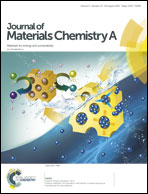Energy efficiency of ionic transport through proton conducting ceramic electrolytes for energy conversion applications†
Abstract
In this study, the efficiency of ionic transport through proton-conducting ceramic electrolytes for energy conversion applications was discussed while considering the energy losses caused by the mixed ionic and electronic conduction and by the ionic transport resistance. It was shown that high energy efficiency cannot be expected with an extremely thin electrolyte because of the significant energy loss due to the internal current leakage. In the case of a fuel cell with a BaZr0.8Y0.2O3−δ electrolyte operating at 873 K, the maximum energy efficiency was estimated to be only 82% when the product of the external current density and the electrolyte thickness was 1.7 × 10−3 A cm−1. The energy efficiency for the ionic transport in BaZr0.8Y0.2O3−δ was compared with those for typical oxide ion conductors, i.e. yttria stabilized zirconia and Ce0.9Gd0.1O1.95−δ, under various fuel cell operating conditions. BaZr0.8Y0.2O3−δ can provide higher energy efficiency than the oxide ion conductors at lower temperatures and under higher current conditions. For the efficient operation of fuel cells using a proton-conducting ceramic as an electrolyte, lower operating temperatures below 873 K is preferable from the viewpoint of energy loss in the electrolyte. The influence of the partial conductivity variation on the energy efficiency was also discussed. It was shown that not only the increase of ionic conductivity but also the decrease of electronic conductivity could improve the energy efficiency if the electrolyte thickness can be optimized. This means that decreasing electronic conductivity as well as increasing proton conductivity can be an effective strategy to develop highly efficient proton conductors for energy conversion applications.



 Please wait while we load your content...
Please wait while we load your content...